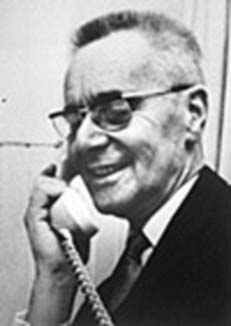
Jan Tinbergen
 المؤلف:
Biography in Encyclopaedia Britannica
المؤلف:
Biography in Encyclopaedia Britannica
 المصدر:
Biography in Encyclopaedia Britannica
المصدر:
Biography in Encyclopaedia Britannica
 الجزء والصفحة:
...
الجزء والصفحة:
...
 21-9-2017
21-9-2017
 839
839
Born: 12 April 1903 in The Hague, Netherlands
Died: 9 June 1994 in Netherlands

Jan Tinbergen's father was a schoolmaster. Jan attended the Hogere Bugerschool in The Hague. This was a special type of school which was designed for children of middle class parents who were aspiring to better their status. These schools allowed entry to the university system after passing additional examinations in Latin and Greek and this Tinbergen did entering the University of Leiden in 1921.
He studied mathematics and theoretical physics at the University of Leiden and was most influenced there by Ehrenfest. Writing in the newspaper NRC-Handelsblad in 1987 he said of his teachers at Leiden:-
To Ehrenfest I owe a great deal. I studied physics at a time when a number of fascinating persons were there together. Ehrenfest would not instruct as such, as he preferred dialogue. Thanks to him I could participate in discussions with Albert Einstein. Also Kamerling Onnes, Lorentz and Zeeman were present. Being a student in the hands of such teachers, you are very fortunate indeed.
However, Tinbergen had political interests associated with his left wing views. At university he founded a club for social democratic students and also founded a student newspaper. In fact some of Tinbergen's first publications were articles he wrote for the socialist newspaper Het Volk in which he examined the effects of the economic depression of 1920-22 on unemployment and how the lives of the poor had been affected.
After completing his undergraduate degree at Leiden, Tinbergen continued to study at Leiden for his doctorate under Ehrenfest's supervision. His thesis combined mathematics, physics and economics. In the introduction Tinbergen thanks Ehrenfest for pointing out to him a topic which could allow him to combine mathematical theories with his political interests. The main part of the thesis is mathematical, studying minimisation problems. Then he gives two appendices, one describing applications of the mathematics to physics, the second appendix giving applications to economics. Tinbergen submitted his dissertation in 1929.
The importance of this work of Tinbergen was that it was one of the first examples of a new idea in mathematics, namely mathematical modelling. Of course mathematical physics had been studied throughout the history of mathematics but Tinbergen's work saw a new path for the applications of mathematics, where the applications could be to a wide variety of areas.
Tinbergen's political views meant that he was unwilling to do military service. He was fortunate in that, only a few years earlier in 1923, legislation had been passed in the Netherlands allowing conscientious objectors to avoid military service. The legislation required that a conscientious objector do government service so Tinbergen joined the Dutch government's Central Bureau of Statistics.
From 1929 to 1945 he worked as a statistician with the Bureau of Statistics. His work on economics in his doctorate had been entirely theoretical, but now he had access to large amounts of data on which to test and develop theories.
From 1933 to 1973 he was professor of economics at The Netherlands School of Economics, Rotterdam. He was appointed to the board of the scientific bureaux of the Dutch Labour Party and he co-authored the Labour Plan in 1935. This plan was based on Tinbergen's mathematically based principles of economics. Alberts writes in [3]:-
The assumption that these principles of economic rationality might really be made to work was substantiated by Tinbergen one year afterwards in an academic debate on the possibilities of active economic policy. In his contribution to the debate Tinbergen projected a 'quantitative stylising of the Dutch economy' to isolate the important factors and their effects by means of a set of definitions and equations. This "model" of the Dutch economy, as he called it (written with quotation marks at first), would allow one to throw some data into the "mathematical machinery" which would then predict the results.
Tinbergen later developed other econometric models, in particular he constructed an econometric model of the USA. In 1969 he jointly won the first Nobel Prize for Economics for this first ever macroeconomic model.
In the late 1930s Tinbergen worked as a scientific advisor for the League of Nations. Then, in 1945, he was appointed as director of the Dutch Central Planning Bureau.
His major publications include Statistical Testing of Business Cycles (1938), Econometrics (1942), Economic Policy (1956), and Income Distribution (1975).
- Biography in Encyclopaedia Britannica.
http://www.britannica.com/eb/article-9072551/Jan-Tinbergen
Books:
- W Sellekaerts (ed.), International trade and finance : essays in honour of Jan Tinbergen (London, 1974).
Articles:
- G Alberts, On connecting socialism and mathematics: Dirk Struik, Jan Burgers, and Jan Tinbergen, Historia Mathematica 21 (3) (1994), 280-305.
 الاكثر قراءة في 1900to1904
الاكثر قراءة في 1900to1904
 اخر الاخبار
اخر الاخبار
اخبار العتبة العباسية المقدسة


